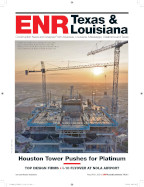Early in the project, the transportation agency was challenged by slow-growing grass in the hill country on the first three project segments. Workers had stripped 4 to 6 in. of topsoil from the surface on all projects and replaced it on all non-paved areas after cuts and fills were finished. But acidic soils in the area are not very conducive to growing grass, Wall says.
To find a solution, the project team tapped into local knowledge. Local farmers spread chicken litter over the soil to add organic compounds that provide the nutrition for grass to grow. Wall says he learned of the technique on a project in the early 1990s when trying to get grass to grow back on 40-ft cuts. Wall, who raises some cattle himself, also gained expertise from a previous agency administrator who also was a farmer. Using the chicken litter "did help grow the grass some and it turned out to be a cheap and easy fix to take care of this," he says, noting that the agency has a contract with a local poultry producer to provide more litter.







